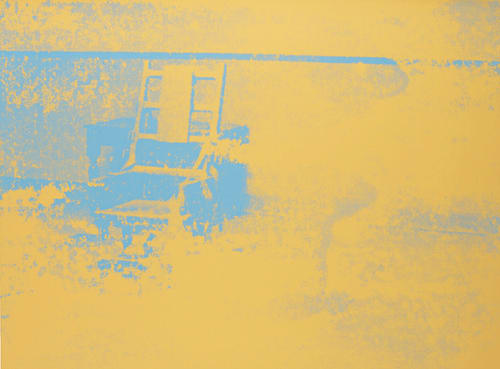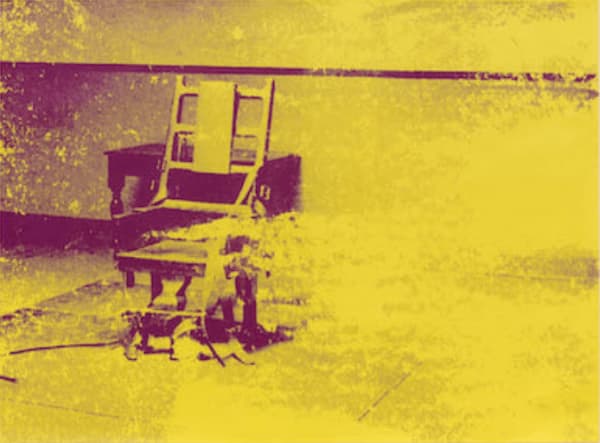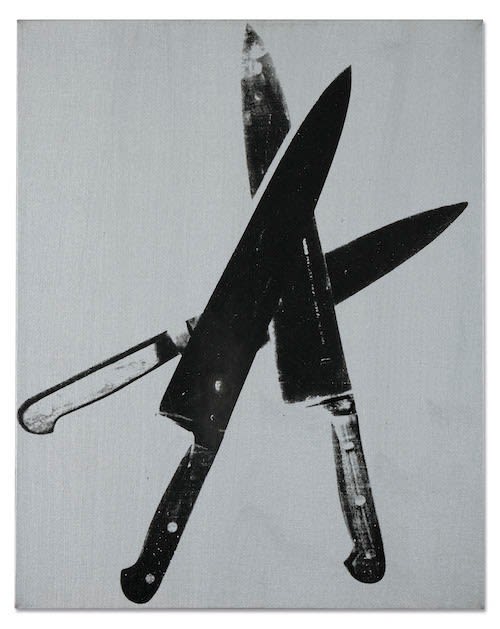Andy Warhol Death and Disaster Exhibition
Andy Warhol was a product of the very American art he produced.
Andy Warhol was a product of the very American art he produced. He was part of everything great and also things society doesn’t agree upon like race, riots, death, drugs and suicide. Having an attitude against American life, placed Warhol above it because he was so knowing but at the same time he could enjoy it. Because his life was so much of an open secret, he was able to operate underneath a mask and reflect exactly who he wanted to present to the world, constantly transforming and perfecting. Through his art, he was able to formulate his fantasies, fears and shame, exploring the dark corners of life that he did not as yet have the courage to explore himself, in a way that we can all identify with on some level. It pushed the culture forward at the same time that it was being created.
Focusing less on Warhol’s graphic reproduction of Campbell’s Soup Cans, this exhibition of Death and Disaster works suggests a more spiritual sentiment. In this scenario, the act of painting and screen printing worked as a meditation on life and the afterlife. The impact of Andrew Warhola’s private life, including the influence of his mother Julia Warhola who was obsessed with death and misfortune and being shot, shaped the vast career of Andy Warhol the artist.
Memento mori, or images preoccupied with concepts of death, appeared throughout Warhol’s body of work. From his Death and Disaster period, he produced the Electric Chair for a show in 1970; along with numerous images taken from magazines showing suicides, car crashes and other tragedies. The idea that mass media dramatized and popularized tragedy was of great interest to Warhol. While his most famous works, like his Campbell’s Soup Cans and celebrity portraits of Marilyn and Jackie, betray a fascination with the glorification of American pop culture objects, death would be of increasing concern to Warhol. His premonition almost came true in 1968 when Warhol was shot three times and nearly killed by Factory follower Valarie Solanas, who accused Warhol of stealing ideas from a script she had presented to him. Initially declared dead, paramedics were able to revive Warhol, who then began a long and slow recovery.
Warhol created The Flash Portfolio in 1968 to depict the continuing media spectacle surrounding President John F. Kennedy’s assassination in 1963. The portfolio contains eleven screen prints based on campaign posters, mass media photographs and advertisements. The cover reproduces the front page of the New York World Telegram from the day of Kennedy’s assassination. Each screen print is accompanied by Teletype reports selected by Phillip Greer that provide a direct media narrative for Warhol’s images. The sequence of the portfolio and its relation to the Teletype text is unknown; it is truly a meditation on the passage of time and death. Warhol’s use of text underlines the notion that our collective understanding of the images is a result of a media construction and not our own personal emotional response.
Full of mystery and contradiction, Warhol’s life can appear as a riddle. Capable of great tenderness and kindness, he could also be unspeakably cruel and manipulative. Wracked with self loathing and insecurity, he simultaneously possessed extraordinary determination and quiet confidence in his own abilities. During his storied career, Andy Warhol was labeled a zealot, genius, fraud, visionary, voyeur, cultural vampire and the voice of a generation. An honest appraisal of his life would offer evidence to support any or all of these assertions. But regardless of one’s own personal opinion of the man and his work, his impact on the world and more specifically on art itself, is undeniable. The passion he was able to elicit from detractors and fans alike is unlike anything the art world has seen before or since. Warhol’s audacious approach utterly defied convention and tradition. Through his choice of subject matter, his use of repetition and his methods of mass production he was able to remove all preciousness and self-seriousness from his work. In doing so, he single handedly reframed the existing paradigm of what constituted art. But it was his innate ability to recognize the right idea at the right time that was perhaps Warhol’s greatest gift. It was this gift that made him a conceptual artist without peer. Discover original Andy Warhol art at Guy Hepner and contact info@guyhepner.com for information on our latest availabilities.
-
 Andy WarholJackie, 1964acrylic and silkscreen ink on canvas
Andy WarholJackie, 1964acrylic and silkscreen ink on canvas
20 x 16 in
50.8 x 40.6 cm -
 Andy WarholBirmingham Race Riot F.S. II.3, 1964Screen print on paper20 x 24 in
Andy WarholBirmingham Race Riot F.S. II.3, 1964Screen print on paper20 x 24 in
50.8 x 61 cmEdition of 500 plus 10 AP -
 Andy WarholJackie Kennedy I F.S. II.13, 1966Screen print on paper20 5/8 x 17 1/8 in
Andy WarholJackie Kennedy I F.S. II.13, 1966Screen print on paper20 5/8 x 17 1/8 in
52.4 x 43.5 cmEdition of 200 plus 50 numbered in Roman Numerals ; signed with a rubber stamp and numbered in pencil on verso -
 Andy WarholJackie Kennedy II F.S. II.14, 1966Screen print24 x 30 in
Andy WarholJackie Kennedy II F.S. II.14, 1966Screen print24 x 30 in
61 x 76.2 cmEdition of 200 plus 50 numbered in Roman numerals ; signed with a rubber stamp and numbered in pencil on verso -
 Andy WarholJackie Kennedy III F.S. II. 15, 1966Screen print40 x 30 in
Andy WarholJackie Kennedy III F.S. II. 15, 1966Screen print40 x 30 in
101.6 x 76.2 cmEdition of 200 plus 50 numbered in Roman Numerals ; signed with a rubber stamp and numbered in pencil on verso -
 Andy WarholMarilyn Monroe F.S. II 24, 1967Screen print36 x 36 in
Andy WarholMarilyn Monroe F.S. II 24, 1967Screen print36 x 36 in
91.4 x 91.4 cmEdition of 250 , 26 AP lettered A - Z on verso -
 Andy WarholFlash - November 22 , 1963 F.S. II 32, 1968Screen print and Teletype text on paper21 x 21 in
Andy WarholFlash - November 22 , 1963 F.S. II 32, 1968Screen print and Teletype text on paper21 x 21 in
53.3 x 53.3 cmEdition of 200 plus 26 numbered in Roman Numerals , 10 Lettered A - J have three additional screen prints , each of which is a composite of images F.S. II 33 and F.S. II 38 -
 Andy WarholFlash - November 22 , 1963 F.S. II 33, 1968Screen print and Teletype text on paper21 x 21 in
Andy WarholFlash - November 22 , 1963 F.S. II 33, 1968Screen print and Teletype text on paper21 x 21 in
53.3 x 53.3 cmEdition of 200 plus 26 numbered in Roman Numerals , 10 Lettered A - J have three additional screen prints , each of which is a composite of images F.S. II 33 and F.S. II 38 -
 Andy WarholFlash - November 22 , 1963 F.S. II 34, 1968Screen print and Teletype text on paper21 x 21 in
Andy WarholFlash - November 22 , 1963 F.S. II 34, 1968Screen print and Teletype text on paper21 x 21 in
53.3 x 53.3 cmEdition of 200 plus 26 numbered in Roman Numerals , 10 Lettered A - J have three additional screen prints , each of which is a composite of images F.S. II 33 and F.S. II 38 -
 Andy WarholFlash - November 22 , 1963 F.S. II 35, 1968Screen print and Teletype text on paper21 x 21 in
Andy WarholFlash - November 22 , 1963 F.S. II 35, 1968Screen print and Teletype text on paper21 x 21 in
53.3 x 53.3 cmEdition of 200 plus 26 numbered in Roman Numerals , 10 Lettered A - J have three additional screen prints , each of which is a composite of images F.S. II 33 and F.S. II 38 -
 Andy WarholFlash - November 22 , 1963 F.S. II 36, 1968Screen print and Teletype text on paper21 x 21 in
Andy WarholFlash - November 22 , 1963 F.S. II 36, 1968Screen print and Teletype text on paper21 x 21 in
53.3 x 53.3 cmEdition of 200 plus 26 numbered in Roman Numerals , 10 Lettered A - J have three additional screen prints , each of which is a composite of images F.S. II 33 and F.S. II 38 -
 Andy WarholFlash - November 22 , 1963 F.S. II 37, 1968Screen print and Teletype text on paper21 x 21 in
Andy WarholFlash - November 22 , 1963 F.S. II 37, 1968Screen print and Teletype text on paper21 x 21 in
53.3 x 53.3 cmEdition of 200 plus 26 numbered in Roman Numerals , 10 Lettered A - J have three additional screen prints , each of which is a composite of images F.S. II 33 and F.S. II 38 -
 Andy WarholFlash - November 22 , 1963 F.S. II 38, 1968Screen print and Teletype text on paper21 x 21 in
Andy WarholFlash - November 22 , 1963 F.S. II 38, 1968Screen print and Teletype text on paper21 x 21 in
53.3 x 53.3 cmEdition of 200 plus 26 numbered in Roman Numerals , 10 Lettered A - J have three additional screen prints , each of which is a composite of images F.S. II 33 and F.S. II 38 -
 Andy WarholFlash - November 22 , 1963 F.S. II 39, 1968Screen print and Teletype text on paper21 x 21 in
Andy WarholFlash - November 22 , 1963 F.S. II 39, 1968Screen print and Teletype text on paper21 x 21 in
53.3 x 53.3 cmEdition of 200 plus 26 numbered in Roman Numerals , 10 Lettered A - J have three additional screen prints , each of which is a composite of images F.S. II 33 and F.S. II 38 -
 Andy WarholFlash - November 22 , 1963 F.S. II 40, 1968Screen print and Teletype text on paper21 x 21 in
Andy WarholFlash - November 22 , 1963 F.S. II 40, 1968Screen print and Teletype text on paper21 x 21 in
53.3 x 53.3 cmEdition of 200 plus 26 numbered in Roman Numerals , 10 Lettered A - J have three additional screen prints , each of which is a composite of images F.S. II 33 and F.S. II 38 -
 Andy WarholFlash - November 22 , 1963 F.S. II 41, 1968Screen print and Teletype text on paper21 x 21 in
Andy WarholFlash - November 22 , 1963 F.S. II 41, 1968Screen print and Teletype text on paper21 x 21 in
53.3 x 53.3 cmEdition of 200 plus 26 numbered in Roman Numerals , 10 Lettered A - J have three additional screen prints , each of which is a composite of images F.S. II 33 and F.S. II 38 -
 Andy WarholFlash - November 22 , 1963 F.S. II 42, 1968Screen print and Teletype text on paper21 x 21 in
Andy WarholFlash - November 22 , 1963 F.S. II 42, 1968Screen print and Teletype text on paper21 x 21 in
53.3 x 53.3 cmEdition of 200 plus 26 numbered in Roman Numerals , 10 Lettered A - J have three additional screen prints , each of which is a composite of images F.S. II 33 and F.S. II 38 -
 Andy WarholFlash - Portfolio November 22 , 1963 F.S. II 32 - 42, 1968Portfolio of eleven screen prints , colophon and Teletype text on paper21 x 21 in (each)
Andy WarholFlash - Portfolio November 22 , 1963 F.S. II 32 - 42, 1968Portfolio of eleven screen prints , colophon and Teletype text on paper21 x 21 in (each)
53.3 x 53.3 cm (each)Edition of 200 plus 26 numbered in Roman Numerals , 10 Lettered A - J have three additional screen prints , each of which is a composite of images F.S. II 33 and F.S. II 38 -
 Andy WarholElectric Chair F.S. II 75, 1971Screen print35 x 48 in
Andy WarholElectric Chair F.S. II 75, 1971Screen print35 x 48 in
88.9 x 121.9 cmEdition of 250 plus 50 AP -
 Andy WarholElectric Chair F.S. II 77, 1971Screen print35 x 48 in
Andy WarholElectric Chair F.S. II 77, 1971Screen print35 x 48 in
88.9 x 121.9 cmEdition of 250 plus 50 AP -
 Andy WarholElectric Chair F.S. II 78, 1971Screen print35 x 48 in
Andy WarholElectric Chair F.S. II 78, 1971Screen print35 x 48 in
88.9 x 121.9 cmEdition of 250 plus 50 AP numbered in Roman numerals -
 Andy WarholElectric Chair F.S. II 80, 1971Screen print35 x 48 in
Andy WarholElectric Chair F.S. II 80, 1971Screen print35 x 48 in
88.9 x 121.9 cmEdition of 250 plus 50 AP -
 Andy WarholElectric Chair F.S. II 82, 1971Screen print35 x 48 in
Andy WarholElectric Chair F.S. II 82, 1971Screen print35 x 48 in
88.9 x 121.9 cmEdition of 250 plus 50 AP -
 Andy WarholElectric Chair F.S. II 83, 1971Screen print35 1/2 x 48 in
Andy WarholElectric Chair F.S. II 83, 1971Screen print35 1/2 x 48 in
90.2 x 121.9 cmEdition of 250 plus 50 AP -
 Andy WarholElectric Chair Portfolio, 1971The complete set of ten screen prints35 x 48 in (each)
Andy WarholElectric Chair Portfolio, 1971The complete set of ten screen prints35 x 48 in (each)
88.9 x 121.9 cm (each)Edition of 250 plus 50 AP (each) -
 Andy WarholElectric Chair (Yellow), 1971Unique screen print on paper35 x 47 1/2 in
Andy WarholElectric Chair (Yellow), 1971Unique screen print on paper35 x 47 1/2 in
88.9 x 120.7 cm -
 Andy WarholElectric Chair, 1971Unique screen print in colors on thin wove paper
Andy WarholElectric Chair, 1971Unique screen print in colors on thin wove paper
35 1/4 x 47 7/8 in
89.5 x 121.6 cm -
 Andy WarholElectric Chair (Retrospective Series), ca . 1978Unique screen print on Strathmore Drawing paper18 x 24 in
Andy WarholElectric Chair (Retrospective Series), ca . 1978Unique screen print on Strathmore Drawing paper18 x 24 in
45.7 x 61 cm -
 Andy WarholGun, 1981-82Synthetic polymer paint and silkscreen inks on canvas16 1/8 x 20 in
Andy WarholGun, 1981-82Synthetic polymer paint and silkscreen inks on canvas16 1/8 x 20 in
40.8 x 50.8 cm -
 Andy WarholKnives, 1981-82Synthetic polymer and screen print ink on canvas20 x 16 in
Andy WarholKnives, 1981-82Synthetic polymer and screen print ink on canvas20 x 16 in
50.8 x 40.6 cm -
 Andy WarholGun, 1982Screen print on paper board22 1/8 x 40 in
Andy WarholGun, 1982Screen print on paper board22 1/8 x 40 in
56.2 x 101.6 cmAuthenticated by the Andy Warhol Art Authentication Board , Identification Number A172.984

































